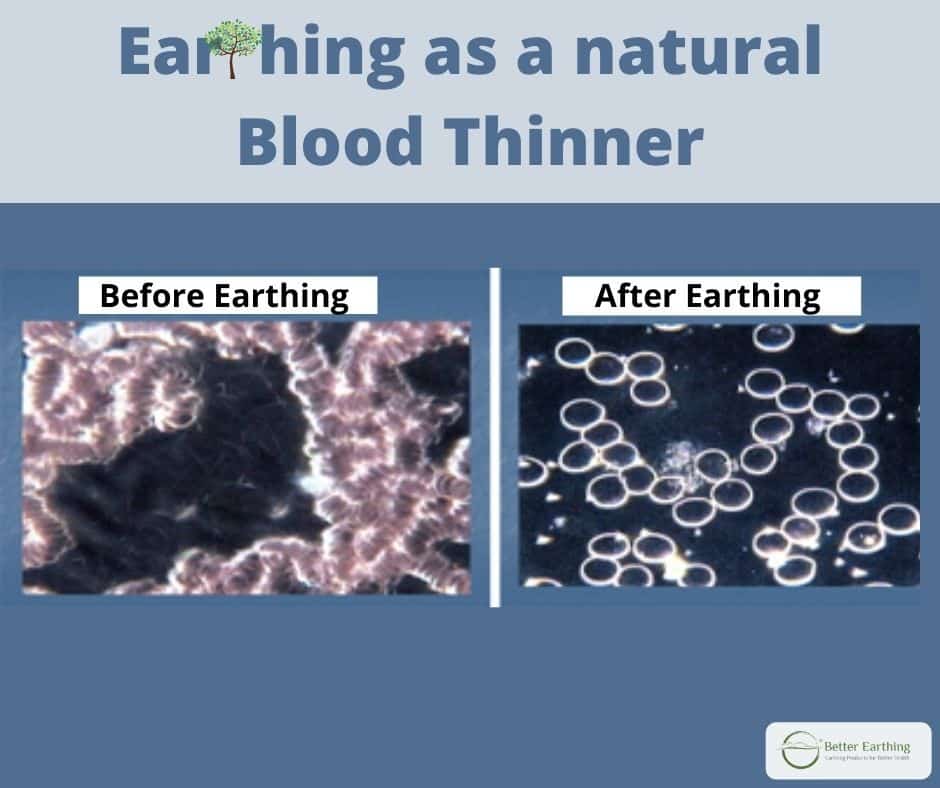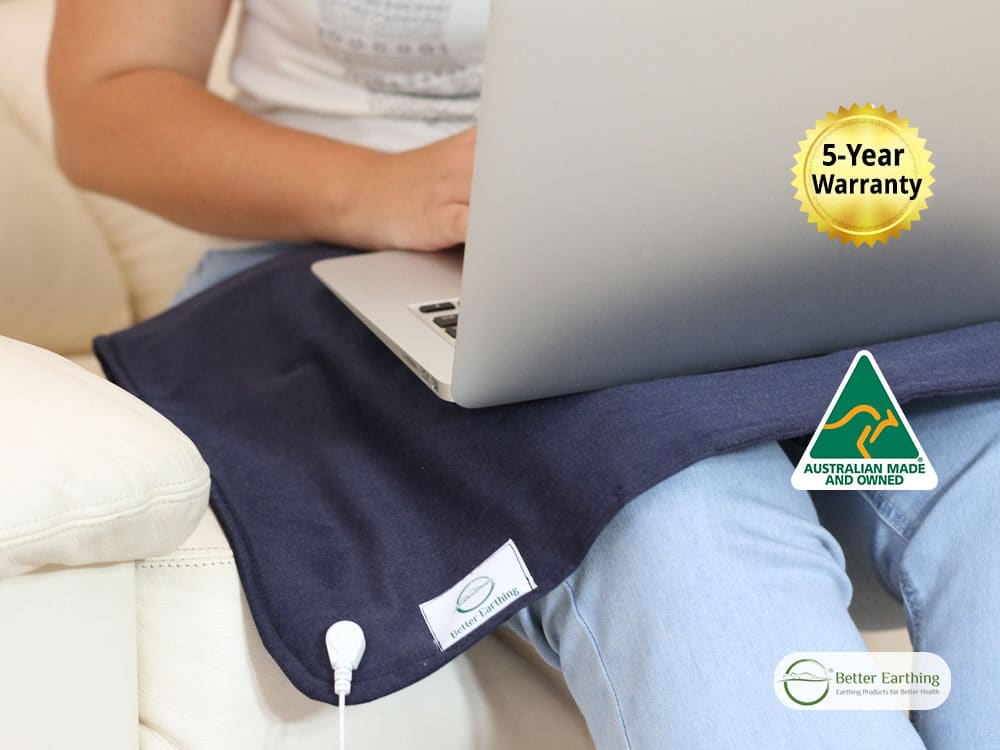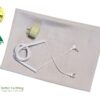Poor Blood Circulation

Blood is one of the most important substances within the human body, and poor blood circulation can lead to a whole host of health problems. Blood is made up of red cells, white cells, and platelets, as well as many other molecules, suspended in a liquid called plasma.
The main function of blood is to transport oxygen, nutrients, and waste products around the body. The second function of blood is protection. It carries white cells that prevent infections and form clots which stop bleeding if you are injured. Finally, blood plays an important role in regulating temperature and water balance within the body.
With so many important functions, it is easy to see why poor blood circulation can cause major health problems. Fortunately, there are many ways to improve blood circulation naturally including dietary and lifestyle changes and a new, innovative approach known as earthing. More on this below.
Symptoms of Poor Blood Circulation
The symptoms of poor blood circulation can vary from person to person depending on what is causing the problem. Some of the most common symptoms include:
- Dark circles under the eyes
- Cold or numb hands or feet
- Varicose veins
- Cramps, swelling, or ulcers of the legs
- Slow wound healing
- Headaches, dizziness, or memory loss
- Increased risk of deep vein thrombosis, stroke, and cardiovascular disease
- Erectile dysfunction in men
The symptoms of poor circulation could be a sign of a more serious, underlying condition. If you are suffering from any of these, discuss them with your physician so that they can investigate further.
What Causes Poor Blood Circulation?
Blood circulates the body in the arteries and veins. Arteries take blood away from the heart to the muscles and organs and veins return it. When the heart pumps blood into the arteries, it is travelling at relatively high pressure. However, on its return journey, the blood pressure is lower. This, coupled with the fact that blood needs to flow upwards to the heart, working against gravity, means that it can get stuck along the way. This results in poor circulation and can lead to the symptoms listed above.
There are several different causes of poor blood circulation.
The most common are:
- High blood viscosity (the blood is thicker than normal)
- Peripheral Artery Disease (the blood vessels are narrowed due to plaques of cholesterol)
- Blood clots
- Diabetes
- Obesity
- Raynaud’s disease
Other conditions that can cause poor blood circulation are anemia, thyroid issues, and certain nerve disorders. There can also be a genetic factor, meaning that if a close relative has a condition that causes poor blood circulation, it is more likely that you will too.
Diagnosis for Poor Blood Circulation
There are several different tests that your doctor might carry out to diagnose the cause of your poor blood circulation.
First, they will likely carry out a physical examination to identify any areas of poor circulation. They will look for coldness, numbness or pain, and other signs such as varicose veins. They will then check your blood pressure to assess how well your heart is pumping the blood in the vessels.
They might carry out blood tests to measure your levels of blood sugar (to test for diabetes), or antibodies (certain antibodies can attack red blood cells). A D-dimer test is a blood test that checks for blood clots that may have formed and broken down over time.
Scans such as ultrasounds and CT scans can also be used to identify clots and look at how well blood is flowing through the vessels.
Ways to Improve Blood Circulation Naturally
There are plenty of ways to improve blood circulation naturally without the need for medication.
Include more citrus fruits in your diet. These are high in vitamin C, which helps to thin the blood and strengthen the blood vessels. Foods that are high in lycopene may also help. These include tomatoes (cooked are best) and watermelon. Other foods that may help circulation are nuts and dark chocolate.
As well as introducing more of these foods into your diet, you should cut down your salt intake as this can increase blood pressure and cause circulatory problems. Many foods contain salt but be especially wary of takeaways, processed foods, ready-made soups, bread, and even cereal.
Reduce your intake of caffeine and alcohol as these both reduce circulation. Instead drink more water and green tea, which is thought to benefit the blood and circulation.
Exercise is also beneficial in helping the blood to circulate more easily. Even 20 minutes a day can be enough to make a difference. Other physical activities that help circulation include massage, skin brushing, and elevating the legs when you are resting.
One common treatment for poor circulation is compression stockings, but in general, you should try to wear loose-fitting clothing that will not interfere with your blood flow. It is also important to keep warm, and hot showers can be a great way to get your circulation going.
Finally, do not smoke. Smoking causes the arteries to harden which makes circulation more difficult as well as causing a whole host of other health problems.
Earthing for Poor Blood Circulation
Earthing, also known as grounding, is an important health discovery. It involves connecting to the earth’s natural electrical charge to rebalance your body and bring about health benefits.
The earth carries a subtle negative electrical charge due to constant lightning strikes across its surface. When you come into conductive contact with the earth, either by walking barefoot or using an indoor earthing product, this charge is transferred to your body. This has the effect of neutralizing harmful free radicals, reducing emotional stress, improving sleep, and relieving pain. Grounding is also an effective treatment for poor blood circulation. Learn more in our article what is grounding.
Earthing for poor blood circulation works by reducing the viscosity (thickness) of the blood. Red blood cells carry a negative electrical charge. This is known as the zeta potential. It stops them from clumping and sticking together. This works in much the same way as two magnets repelling one another if you place them side by side.
Grounding naturally increases this zeta potential, meaning that the red cells repel each other more readily. This thins the blood, preventing clotting and improving circulation.
Research on Earthing and Blood Circulation
A research study published in the Journal of Alternative and Complementary Medicine in 2013 showed the ability of earthing to increase zeta potential and decrease the clumping of red blood cells. It found that after just two hours of earthing, there were significantly more clusters of one and two red blood cells and far fewer clusters of three or more.
This photo shows one person’s blood flow before and after earthing using a darkfield microscope.

In addition, the subjects who had symptoms of pain at the beginning of the study reported that it was either completely gone or significantly better after earthing.
A 2015 study showed that earthing improved circulation and inflammation after just one hour. Subjects were randomly assigned to either earthing or sham earthing groups. Thermal imaging was used. It confirmed that circulation was improved in the torsos and faces of the earthed subjects.
Grounding for Numb Feet
One common symptom of poor blood circulation is numb feet, especially in patients with diabetes. This is a condition, which is difficult to treat with conventional medicine, which is limited to controlling blood sugar. However, earthing has a very positive effect.
Dr David Richards, M.B.B.S has reported his findings when treating patients with numb feet with earthing and states:
“In most cases, I have seen at least some improvement of foot numbness after an initial hour grounding session in my office where patients simply put their bare feet on an Earthing mat. Some have not been able to come back immediately but generally, improvement lasts for as long as ten days after one session. The more they do, the better, though. One diabetic woman said that her numb feet had improved by 75 percent after that one session. She had never told me she had numb feet. After two sessions, her numbness was resolved. To date, the numb feet of twenty-one out of twenty-one patients are mostly resolved!”
And it is not just diabetics who are benefiting. Dr Richards also reports that patients have recovered from numb feet following spinal surgery, as well as experiencing improvement in a whole range of other symptoms.
Contraindications for Earthing
Although earthing is a natural therapy and generally very safe, some people should exercise caution.
Because of its ability to thin the blood, patients who are taking blood-thinning medication such as aspirin, warfarin (Coumadin), or clopidogrel (Plavix) should consult their physician before starting with earthing.
If you are suffering from any long-term health conditions, you should always check with your physician before starting any complementary therapy, including earthing. And remember to never stop taking any prescribed medication without speaking to your healthcare provider first.
How to Get Started with Grounding
You can get started with earthing by simply walking barefoot on the earth. Just a few minutes can be enough to bring your body into conductive contact with its electrical charge, allowing you to experience the many benefits of earthing.
However, since this is not always practical, you can now experience earthing in the comfort of your own home. A wide range of indoor earthing products are available, from grounding mats that you can sit on, to grounding sheets and underlays for your bed that allows you earth while you sleep. This makes earthing a safe and convenient treatment for poor blood circulation as well as many other conditions.
Earthing Research
Chevalier G, Sinatra ST, Oschman JL, Delany RM. ‘Earthing (grounding) the human body reduces blood viscosity—a major factor in cardiovascular disease.’ Journal of Alternative and Complementary Medicine, 2013, Volume 19 (2). 102-110
Chevalier G, Melvin G, Barsotti T. ‘One-Hour Contact with the Earth’s Surface (Grounding) Improves Inflammation and Blood Flow – A Randomized, Double-Blind, Pilot Study’ Health. 2015, 7 (8), 1022-59
Oschman, James L, Chevalier G, Brown R. ‘The effects of grounding (earthing) on inflammation, the immune response, wound healing, and prevention and treatment of chronic inflammatory and autoimmune disease’ Journal of Inflammation Research, 2015. March 24.





